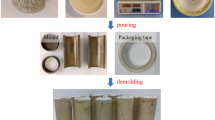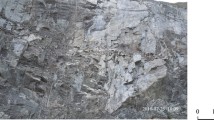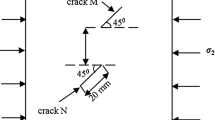Abstract
Anti-plane punch-through shear test and anti-plane four-point bending test are used to study the crack initiation and propagation under anti-plane shear (Mode III) loading. The tensile and shear stresses at the crack tip are calcualted by finite element method. The results show that under Mode III loading the maximum principal stress σ1 at crack tip is smaller or a little larger than the maximum shear stress τmax. Since the tensile strength of brittle rock is much lower than its shear strength, σ1 is easy to reach its critical value before τmax reaches its critical value and thus results in Mode I fracture. The fracture trajectory is helicoid and the normal direction of tangential plane with the fractured helicoid is along the predicted direction of the maximum principal stress at the notch tip. It is further proved that Mode I instead of Mode III fracture occurs in brittle rock under Mode III loading. The fracture mode depending on the fracture mechanism must be distinguished from the loading form.
Similar content being viewed by others
References
Bi X S, Cheng J, Chen X L. Moving crack for functionally grated material in an infinite length strip under antiplane shear [J]. Theoretical and Applied Fracture Mechanics, 2003, 39(1): 89–97.
Farshad M, Flüeler P. Investigation of Mode III fracture toughness using an anti-clastic plate bending method. [J]. Engineering Fracture Mechanics, 1998, 60(5–6): 597–603.
Suemasu H. An experimental method to measure the mode III interlaminar fracture toughness of composite laminates [J]. Composites Science and Technology, 1999, 59(7): 1015–1021.
Hull D. The effect of mixed mode I/III on crack evolution in the brittle solids [J]. Int J Fract, 1995, 70: 59–79.
Tschegg E K, Suresh S. Mode III fracture of 4340 steel: effect of temperature and fracture surface interference [J]. Metal Trans, 1988, 19A: 3044–3055.
Ehart R J A, Stanzl-Tschegg S E, Tschegg E K. Crack face interaction and mixed mode fracture of wood composites during mode III loading [J]. Engineering Fracture Mechanics, 1998, 61(2): 253–278.
Author information
Authors and Affiliations
Corresponding author
Additional information
Foundation item: Project (50374073) supported by the National Natural Science Foundation of China; project (2002032256) supported by the Postdoctor Science Foundation of China
Rights and permissions
About this article
Cite this article
Rao, Qh., Liao, Zf. Rock fracture under anti-plane shear (Mode III) loading. J Cent. South Univ. Technol. 12 (Suppl 1), 125–128 (2005). https://doi.org/10.1007/s11771-005-0385-2
Received:
Accepted:
Published:
Issue Date:
DOI: https://doi.org/10.1007/s11771-005-0385-2




